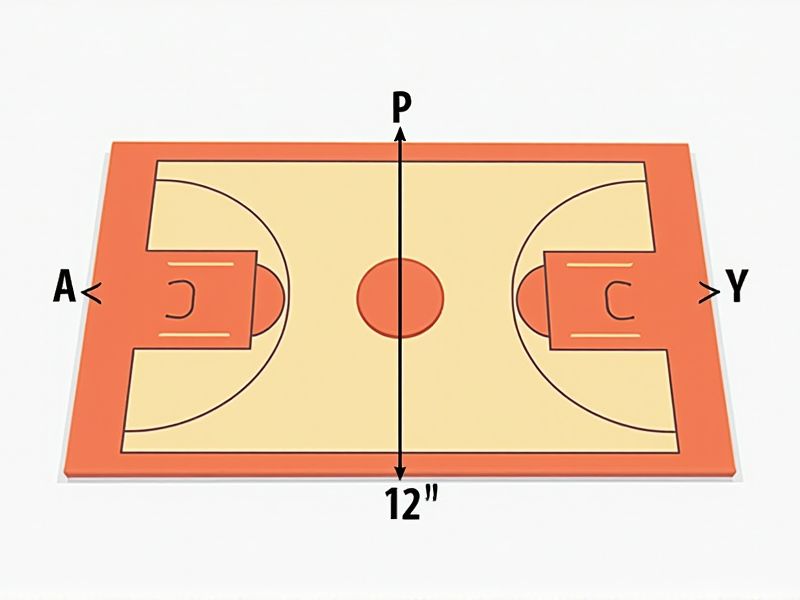
Knowing the standard dimensions of a basketball court is helpful for players, coaches, and facility managers to ensure fair play and effective practice. According to official NBA regulations, a professional basketball court measures 94 feet long by 50 feet wide. High school courts are typically a bit smaller, measuring 84 feet by 50 feet. Understanding these measurements can help you set up drills, organize games, and purchase the correct equipment for your space.
Regulation Length: 94 Feet
A regulation basketball court measures 94 feet in length, providing ample space for players to execute various strategies and plays. This standard size also enhances the game's overall flow, permitting fast breaks and dynamic movements. The court is divided by a center circle, which has a diameter of 12 feet, ensuring proper spacing during jump balls and other crucial plays. Understanding the dimensions of a basketball court is essential for both players and coaches to optimize performance and game strategy.
Regulation Width: 50 Feet
A standard basketball court measures 94 feet in length and 50 feet in width, providing ample space for competitive play. The court is divided into two main sections by the midcourt line, enhancing gameplay strategy and flow. Key areas include the three-point line, which is 23.75 feet from the basket at the top, and the free-throw line, positioned 15 feet from the backboard. Understanding these dimensions is essential for players and coaches aiming to optimize performance within regulation standards.
Free-Throw Line Distance: 15 Feet From Backboard
A standard basketball court features a free-throw line situated precisely 15 feet from the backboard, ensuring a consistent shooting distance for players. This distance is crucial for training athletes to develop accurate free-throw techniques, as it provides a benchmark for skill assessment. The overall dimensions of a regulation court measure 94 feet in length and 50 feet in width, emphasizing the significance of spatial awareness during gameplay. When practicing your free throws, maintaining this 15-foot distance can significantly enhance your shooting performance over time.
Three-Point Line Distance: Varies By League
The distance of the three-point line from the basket varies significantly by league; in the NBA, it measures 23.75 feet (7.24 meters) at the top, with a 22-foot (6.7 meters) distance in the corners. For NCAA basketball, the three-point line is set at 22.1 feet (6.75 meters), while FIBA regulations establish it at 22.15 feet (6.75 meters) for international play. Such variations impact shooting strategies and player skills, emphasizing the importance of understanding your league's specifications. Knowing these distances can enhance your appreciation for game dynamics and player performance.
Key (Paint) Width: 16 Feet
The standard width of the key, commonly referred to as the paint, on a basketball court is precisely 16 feet. This area is crucial for offensive and defensive plays, as it dictates player positioning during rebounds and post moves. A properly marked key ensures compliance with regulations set by organizations like the NBA and FIBA. Understanding these dimensions can enhance your strategic approach to the game, making the most of the space available on the court.
Basket Height: 10 Feet
A standard basketball court measures 94 feet in length and 50 feet in width, providing ample space for gameplay. The hoop, or basket, is positioned at a height of 10 feet from the playing surface, ensuring uniformity across all levels of play. The three-point line is set at a distance of 22 feet from the basket at the top of the arc in the NBA and 19.75 feet in NCAA games. Your understanding of these dimensions is crucial for enhancing your skills and strategy on the court.
Center Circle Diameter: 12 Feet
The center circle on a standard basketball court has a diameter of 12 feet, serving a crucial role in the regulation of jump balls and establishing player positioning at the game's start. This circular area is strategically placed at the center of the court, providing a clear visual marker for foul shots and inbounds plays. Each of your team members must understand the significance of this zone, particularly during critical moments when possession is at stake. By adhering to these dimensional standards, the integrity and fairness of the game are upheld.
Restricted Arc Radius: 4 Feet
The NBA regulation basketball court features a restricted area arc with a radius of 4 feet from the center of the basket. This arc is critical in determining player fouls during offensive plays, promoting fair competition and player safety. You will find the restricted area marked clearly, helping referees evaluate charging and blocking violations. Proper adherence to this standard ensures that the game remains fluid while safeguarding players from unnecessary contact within this zone.
Baseline To Free-Throw Line: 19 Feet
A standard basketball court features a crucial measurement from the baseline to the free-throw line, which is set at 19 feet. This distance plays a significant role in gameplay, influencing shooting strategies and player positioning. Understanding this dimension is essential for both players and coaches to develop effective offensive and defensive tactics. The free-throw line itself, positioned 15 feet from the backboard, further highlights the importance of precise measurements in the sport.
Sideline Space Outside Boundary: Minimum 3 Feet
The standard basketball court mandates a minimum sideline space of 3 feet outside the boundary lines. This area is essential for player safety, allowing athletes to evade potentially hazardous situations while maintaining fluid game dynamics. By adhering to this 3-foot requirement, venues can enhance spectator experience and ensure that players have ample room to operate during fast-paced gameplay. Ensuring compliance with these specifications contributes to the overall integrity and professionalism of the sport.
